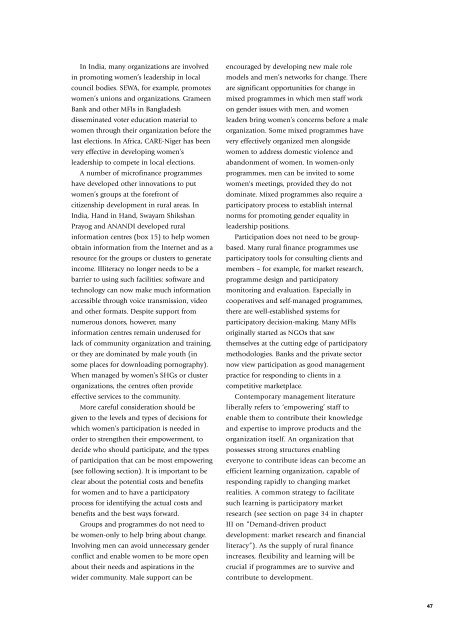Gender and rural microfinance: Reaching and empowering ... - IFAD
Gender and rural microfinance: Reaching and empowering ... - IFAD
Gender and rural microfinance: Reaching and empowering ... - IFAD
Create successful ePaper yourself
Turn your PDF publications into a flip-book with our unique Google optimized e-Paper software.
In India, many organizations are involved<br />
in promoting women’s leadership in local<br />
council bodies. SEWA, for example, promotes<br />
women’s unions <strong>and</strong> organizations. Grameen<br />
Bank <strong>and</strong> other MFIs in Bangladesh<br />
disseminated voter education material to<br />
women through their organization before the<br />
last elections. In Africa, CARE-Niger has been<br />
very effective in developing women’s<br />
leadership to compete in local elections.<br />
A number of <strong>microfinance</strong> programmes<br />
have developed other innovations to put<br />
women’s groups at the forefront of<br />
citizenship development in <strong>rural</strong> areas. In<br />
India, H<strong>and</strong> in H<strong>and</strong>, Swayam Shikshan<br />
Prayog <strong>and</strong> ANANDI developed <strong>rural</strong><br />
information centres (box 15) to help women<br />
obtain information from the Internet <strong>and</strong> as a<br />
resource for the groups or clusters to generate<br />
income. Illiteracy no longer needs to be a<br />
barrier to using such facilities: software <strong>and</strong><br />
technology can now make much information<br />
accessible through voice transmission, video<br />
<strong>and</strong> other formats. Despite support from<br />
numerous donors, however, many<br />
information centres remain underused for<br />
lack of community organization <strong>and</strong> training,<br />
or they are dominated by male youth (in<br />
some places for downloading pornography).<br />
When managed by women’s SHGs or cluster<br />
organizations, the centres often provide<br />
effective services to the community.<br />
More careful consideration should be<br />
given to the levels <strong>and</strong> types of decisions for<br />
which women’s participation is needed in<br />
order to strengthen their empowerment, to<br />
decide who should participate, <strong>and</strong> the types<br />
of participation that can be most <strong>empowering</strong><br />
(see following section). It is important to be<br />
clear about the potential costs <strong>and</strong> benefits<br />
for women <strong>and</strong> to have a participatory<br />
process for identifying the actual costs <strong>and</strong><br />
benefits <strong>and</strong> the best ways forward.<br />
Groups <strong>and</strong> programmes do not need to<br />
be women-only to help bring about change.<br />
Involving men can avoid unnecessary gender<br />
conflict <strong>and</strong> enable women to be more open<br />
about their needs <strong>and</strong> aspirations in the<br />
wider community. Male support can be<br />
encouraged by developing new male role<br />
models <strong>and</strong> men’s networks for change. There<br />
are significant opportunities for change in<br />
mixed programmes in which men staff work<br />
on gender issues with men, <strong>and</strong> women<br />
leaders bring women’s concerns before a male<br />
organization. Some mixed programmes have<br />
very effectively organized men alongside<br />
women to address domestic violence <strong>and</strong><br />
ab<strong>and</strong>onment of women. In women-only<br />
programmes, men can be invited to some<br />
women's meetings, provided they do not<br />
dominate. Mixed programmes also require a<br />
participatory process to establish internal<br />
norms for promoting gender equality in<br />
leadership positions.<br />
Participation does not need to be groupbased.<br />
Many <strong>rural</strong> finance programmes use<br />
participatory tools for consulting clients <strong>and</strong><br />
members – for example, for market research,<br />
programme design <strong>and</strong> participatory<br />
monitoring <strong>and</strong> evaluation. Especially in<br />
cooperatives <strong>and</strong> self-managed programmes,<br />
there are well-established systems for<br />
participatory decision-making. Many MFIs<br />
originally started as NGOs that saw<br />
themselves at the cutting edge of participatory<br />
methodologies. Banks <strong>and</strong> the private sector<br />
now view participation as good management<br />
practice for responding to clients in a<br />
competitive marketplace.<br />
Contemporary management literature<br />
liberally refers to ‘<strong>empowering</strong>’ staff to<br />
enable them to contribute their knowledge<br />
<strong>and</strong> expertise to improve products <strong>and</strong> the<br />
organization itself. An organization that<br />
possesses strong structures enabling<br />
everyone to contribute ideas can become an<br />
efficient learning organization, capable of<br />
responding rapidly to changing market<br />
realities. A common strategy to facilitate<br />
such learning is participatory market<br />
research (see section on page 34 in chapter<br />
III on “Dem<strong>and</strong>-driven product<br />
development: market research <strong>and</strong> financial<br />
literacy”). As the supply of <strong>rural</strong> finance<br />
increases, flexibility <strong>and</strong> learning will be<br />
crucial if programmes are to survive <strong>and</strong><br />
contribute to development.<br />
47

















